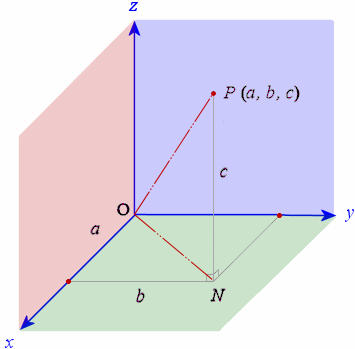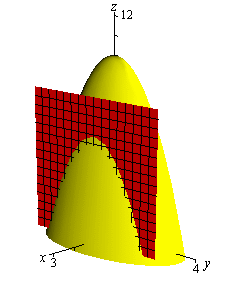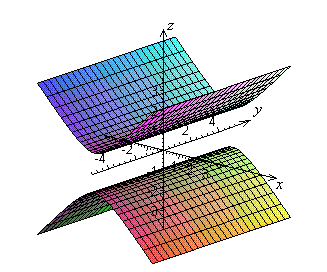
Home
The Fundamental Theorem of Calculus
Three Different ConceptsThe Fundamental Theorem of Calculus (Part 2)
The Fundamental Theorem of Calculus (Part 1)
More FTC 1
The Indefinite Integral and the Net Change
Indefinite Integrals and Anti-derivativesA Table of Common Anti-derivatives
The Net Change Theorem
The NCT and Public Policy
Substitution
Substitution for Indefinite IntegralsExamples to Try
Revised Table of Integrals
Substitution for Definite Integrals
Examples
Area Between Curves
Computation Using IntegrationTo Compute a Bulk Quantity
The Area Between Two Curves
Horizontal Slicing
Summary
Volumes
Slicing and Dicing SolidsSolids of Revolution 1: Disks
Solids of Revolution 2: Washers
More Practice
Integration by Parts
Integration by PartsExamples
Integration by Parts with a definite integral
Going in Circles
Tricks of the Trade
Integrals of Trig Functions
Antiderivatives of Basic Trigonometric FunctionsProduct of Sines and Cosines (mixed even and odd powers or only odd powers)
Product of Sines and Cosines (only even powers)
Product of Secants and Tangents
Other Cases
Trig Substitutions
How Trig Substitution WorksSummary of trig substitution options
Examples
Completing the Square
Partial Fractions
IntroductionLinear Factors
Irreducible Quadratic Factors
Improper Rational Functions and Long Division
Summary
Strategies of Integration
SubstitutionIntegration by Parts
Trig Integrals
Trig Substitutions
Partial Fractions
Improper Integrals
Type 1 - Improper Integrals with Infinite Intervals of IntegrationType 2 - Improper Integrals with Discontinuous Integrands
Comparison Tests for Convergence
Differential Equations
IntroductionSeparable Equations
Mixing and Dilution
Models of Growth
Exponential Growth and DecayLogistic Growth
Infinite Sequences
Approximate Versus Exact AnswersExamples of Infinite Sequences
Limit Laws for Sequences
Theorems for and Examples of Computing Limits of Sequences
Monotonic Covergence
Infinite Series
IntroductionGeometric Series
Limit Laws for Series
Test for Divergence and Other Theorems
Telescoping Sums and the FTC
Integral Test
Road MapThe Integral Test
Estimates of Value of the Series
Comparison Tests
The Basic Comparison TestThe Limit Comparison Test
Convergence of Series with Negative Terms
Introduction, Alternating Series,and the AS TestAbsolute Convergence
Rearrangements
The Ratio and Root Tests
The Ratio TestThe Root Test
Examples
Strategies for testing Series
Strategy to Test Series and a Review of TestsExamples, Part 1
Examples, Part 2
Power Series
Radius and Interval of ConvergenceFinding the Interval of Convergence
Power Series Centered at $x=a$
Representing Functions as Power Series
Functions as Power SeriesDerivatives and Integrals of Power Series
Applications and Examples
Taylor and Maclaurin Series
The Formula for Taylor SeriesTaylor Series for Common Functions
Adding, Multiplying, and Dividing Power Series
Miscellaneous Useful Facts
Applications of Taylor Polynomials
Taylor PolynomialsWhen Functions Are Equal to Their Taylor Series
When a Function Does Not Equal Its Taylor Series
Other Uses of Taylor Polynomials
Partial Derivatives
Visualizing Functions in 3 DimensionsDefinitions and Examples
An Example from DNA
Geometry of Partial Derivatives
Higher Order Derivatives
Differentials and Taylor Expansions
Multiple Integrals
BackgroundWhat is a Double Integral?
Volumes as Double Integrals
Iterated Integrals over Rectangles
How To Compute Iterated IntegralsExamples of Iterated Integrals
Cavalieri's Principle
Fubini's Theorem
Summary and an Important Example
Double Integrals over General Regions
Type I and Type II regionsExamples 1-4
Examples 5-7
Order of Integration
Visualizing Functions in 3 Dimensions
In this and the next few modules, we will be discussing functions
of more than one variable. Our familiar $y=f(x)$ is a curve in 2-dimensional
space, with points $(x,y)$. Now consider $z=f(x,y)$, which is a function of
two (independent) variables, $x$ and $y$.
Here, $z$ is the value assigned to the function, which is unique
given $x$ and $y$ (because $f$ is a function). This function
is a surface in 3-dimensional space, with points
having coordinates $(x,y,z)$. Similarly, $w=f(x,y,z)$ is a
function of three variables, living in the very-difficult-to-see
4-dimensional space. Much can be (and is) said to help you
thoroughly understand these functions in a standard third-semester
calculus course, but we are being brief here. Our goal is to
give you a quick introduction to the ideas of partial
differentiation and multiple integration.
| It can be challenging to see 3-space on the
two dimensional page. Think of this graphic as a
room. View the origin $O$ as being the back corner, so the back wall is purple, the left wall is pink, and the floor is green. The
point $(a,b,c)$ is $a$ units in the $x$-direction (along the
$x$-axis toward the front of the room), $b$ units in the
$y$-direction (to the right), and $c$-units in the
$z$-direction (up). Our earthly world is 3-dimensional
space, and if oriented with an origin, all points in space
have three coordinates. http://www.intmath.com/
|
 |
The function $z=f(x,y)$ can be represented in 3-space as a surface. This yellow paraboloid is the surface given by the function $f(x,y)=10-4x^2-y^2$. Notice that $f(0,0)=10$, giving the point $(0,0,10)$ on the surface. Fixing $x=1$, we get a 2-dimensional slice (by the red slicer) of the surface, $z=6-y^2$, which is a parabola in the $yz$-plane, upside down (since the $y$ coefficient is negative) and shifted up by 6 units. tutorial.math.lamar.edu
|
 |
The graph here is of $z^2=1+x^2$.
Two things to notice. First, this is not a function,
since there is more than one value of $z$ for given values
of $x$ and $y$. (We have a vertical line test in
this orientation of 3 dimensions, which this curve
fails.) We can represent this curve as two
functions: $f(x,y)=\sqrt{1+x^2}$ (the upper
surface), and $g(x,y)=-\sqrt{1+x^2}$ (the lower
surface). The second thing we notice is that there
is no $y$ in the formula, which means $y$ doesn't
matter. For example, $f(0,77)=f(0,-8)=f(0,\text{any
number})=1$, and $g(0,46)=g(0,0)=g(0,\text{any
number})=-1$. Graphically, this means we get a line
in the $y$-direction for any given $x$ and $z$ values.
|
 |
When you have trouble picturing "slices"
when we take derivatives, etc., refer back to these graphs.
You are not expected to be able to graph such functions in this
course, but when you are trying to visualize how we take partial
derivatives, understanding points on and slices of surfaces will
be very helpful.